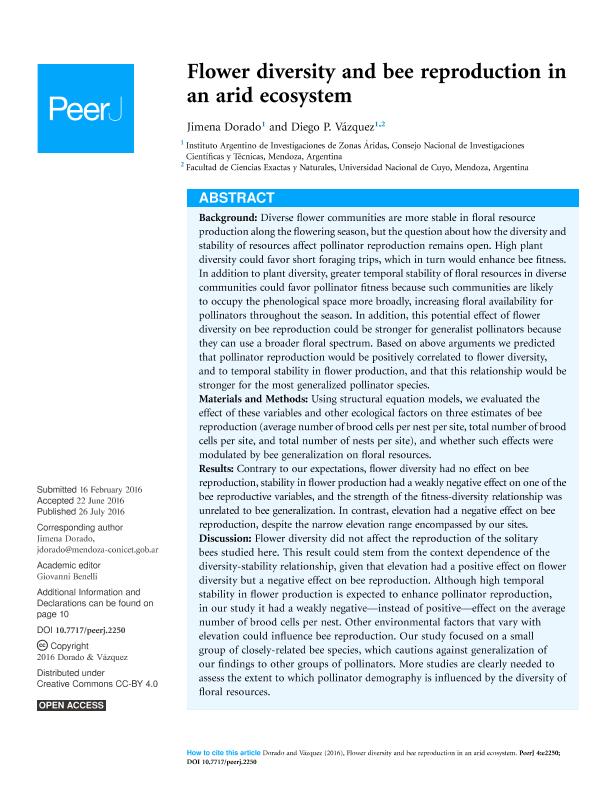Artículo
Flower diversity and bee reproduction in an arid ecosystem.
Fecha de publicación:
06/2016
Editorial:
PeerJ, Inc
Revista:
PeerJ
ISSN:
2376-5992
Idioma:
Inglés
Tipo de recurso:
Artículo publicado
Clasificación temática:
Resumen
Background: Diverse flower communities are more stable in floral resourceproduction along the flowering season, but the question about how the diversity and stability of resources affect pollinator reproduction remains open. High plant diversity could favor short foraging trips, which in turn would enhance bee fitness.In addition to plant diversity, greater temporal stability of floral resources in diverse communities could favor pollinator fitness because such communities are likely to occupy the phenological space more broadly, increasing floral availability for pollinators throughout the season. In addition, this potential effect of flower diversity on bee reproduction could be stronger for generalist pollinators because they can use a broader floral spectrum. Based on above arguments we predicted that pollinator reproduction would be positively correlated to flower diversity, and to temporal stability in flower production, and that this relationship would be stronger for the most generalized pollinator species.Materials and Methods: Using structural equation models, we evaluated theeffect of these variables and other ecological factors on three estimates of bee reproduction (average number of brood cells per nest per site, total number of brood cells per site, and total number of nests per site), and whether such effects were modulated by bee generalization on floral resources.Results: Contrary to our expectations, flower diversity had no effect on bee reproduction, stability in flower production had a weakly negative effect on one of the bee reproductive variables, and the strength of the fitness-diversity relationship was unrelated to bee generalization. In contrast, elevation had a negative effect on bee reproduction, despite the narrow elevation range encompassed by our sites.Discussion: Flower diversity did not affect the reproduction of the solitary bees studied here. This result could stem from the context dependence of the diversity-stability relationship, given that elevation had a positive ffect on flower diversity but a negative effect on bee reproduction. Although high temporalstability in flower production is expected to enhance pollinator eproduction,in our study it had a weakly negative?instead of positive?effect on the veragenumber of brood cells per nest. Other environmental factors that vary withelevation could influence bee reproduction. Our study focused on a smallgroup of closely-related bee species, which cautions against generalization ofour findings to other groups of pollinators. More studies are clearly eeded toassess the extent to which pollinator demography is influenced by the iversity offloral resources.
Palabras clave:
Pollination
,
Flower Diversity
,
Bee Fitness
Archivos asociados
Licencia
Identificadores
Colecciones
Articulos(IADIZA)
Articulos de INST. ARG DE INVEST. DE LAS ZONAS ARIDAS
Articulos de INST. ARG DE INVEST. DE LAS ZONAS ARIDAS
Citación
Dorado, Jimena; Vazquez, Diego P.; Flower diversity and bee reproduction in an arid ecosystem.; PeerJ, Inc ; PeerJ; 2016; 4; 6-2016; 1-13; e2250
Compartir
Altmétricas




